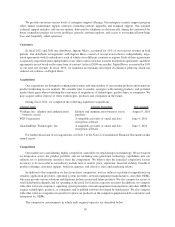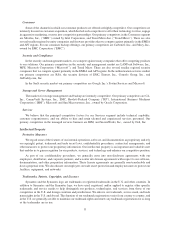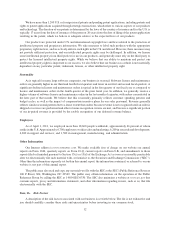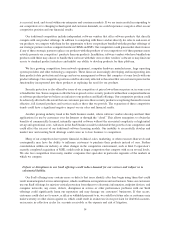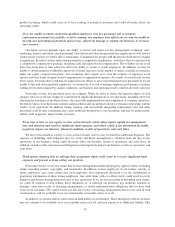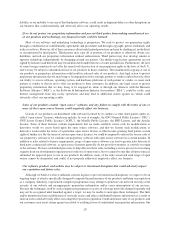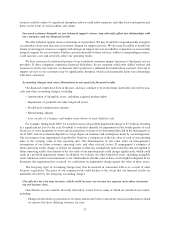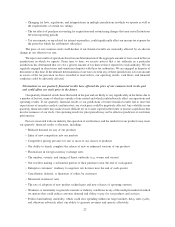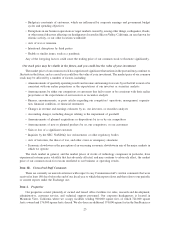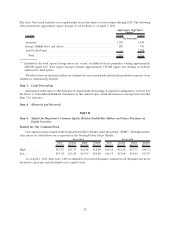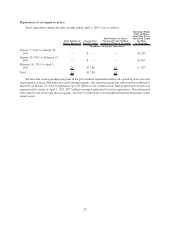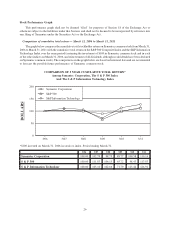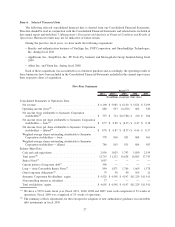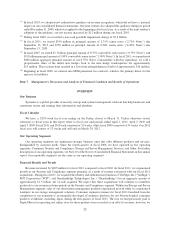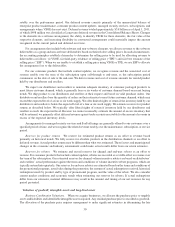Symantec 2011 Annual Report Download - page 90
Download and view the complete annual report
Please find page 90 of the 2011 Symantec annual report below. You can navigate through the pages in the report by either clicking on the pages listed below, or by using the keyword search tool below to find specific information within the annual report.liability, or our inability to use any of this third party software, could result in shipment delays or other disruptions in
our business that could materially and adversely affect our operating results.
If we do not protect our proprietary information and prevent third parties from making unauthorized use
of our products and technology, our financial results could be harmed.
Most of our software and underlying technology is proprietary. We seek to protect our proprietary rights
through a combination of confidentiality agreements and procedures and through copyright, patent, trademark, and
trade secret laws. However, all of these measures afford only limited protection and may be challenged, invalidated,
or circumvented by third parties. Third parties may copy all or portions of our products or otherwise obtain, use,
distribute, and sell our proprietary information without authorization. Third parties may also develop similar or
superior technology independently by designing around our patents. Our shrink-wrap license agreements are not
signed by licensees and therefore may be unenforceable under the laws of some jurisdictions. Furthermore, the laws
of some foreign countries do not offer the same level of protection of our proprietary rights as the laws of the U.S.,
and we may be subject to unauthorized use of our products in those countries. The unauthorized copying or use of
our products or proprietary information could result in reduced sales of our products. Any legal action to protect
proprietary information that we may bring or be engaged in with a strategic partner or vendor could adversely affect
our ability to access software, operating system, and hardware platforms of such partner or vendor, or cause such
partner or vendor to choose not to offer our products to their customers. In addition, any legal action to protect
proprietary information that we may bring or be engaged in, alone or through our alliances with the Business
Software Alliance (“BSA”), or the Software & Information Industry Association (“SIIA”), could be costly, may
distract management from day-to-day operations, and may lead to additional claims against us, which could
adversely affect our operating results.
Some of our products contain “open source” software, and any failure to comply with the terms of one or
more of these open source licenses could negatively affect our business.
Certain of our products are distributed with software licensed by its authors or other third parties under so-
called “open source” licenses, which may include, by way of example, the GNU General Public License (“GPL”),
GNU Lesser General Public License (“LGPL”), the Mozilla Public License, the BSD License, and the Apache
License. Some of these licenses contain requirements that we make available source code for modifications or
derivative works we create based upon the open source software, and that we license such modifications or
derivative works under the terms of a particular open source license or other license granting third parties certain
rights of further use. By the terms of certain open source licenses, we could be required to release the source code of
our proprietary software if we combine our proprietary software with open source software in a certain manner. In
addition to risks related to license requirements, usage of open source software can lead to greater risks than use of
third party commercial software, as open source licensors generally do not provide warranties or controls on origin
of the software. We have established processes to help alleviate these risks, including a review process for screening
requests from our development organizations for the use of open source, but we cannot be sure that all open source is
submitted for approval prior to use in our products. In addition, many of the risks associated with usage of open
source cannot be eliminated, and could, if not properly addressed, negatively affect our business.
Our software products and website may be subject to intentional disruption that could adversely impact
our reputation and future sales.
Although we believe we have sufficient controls in place to prevent intentional disruptions, we expect to be an
ongoing target of attacks specifically designed to impede the performance of our products and harm our reputation
as a company. Similarly, experienced computer programmers may attempt to penetrate our network security or the
security of our website and misappropriate proprietary information and/or cause interruptions of our services.
Because the techniques used by such computer programmers to access or sabotage networks change frequently and
may not be recognized until launched against a target, we may be unable to anticipate these techniques. The theft
and/or unauthorized use or publication of our trade secrets and other confidential business information as a result of
such an event could adversely affect our competitive position, reputation, brand and future sales of our products, and
our customers may assert claims against us related to resulting losses of confidential or proprietary information. Our
20


